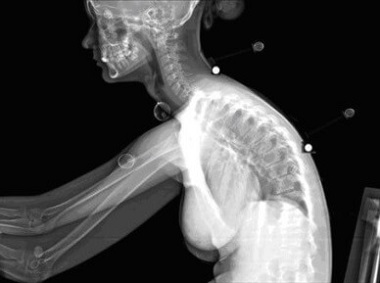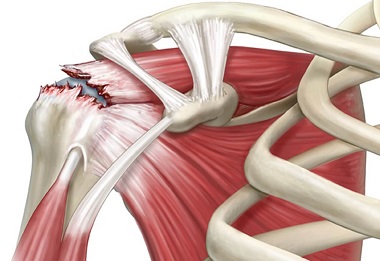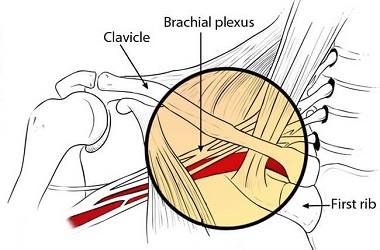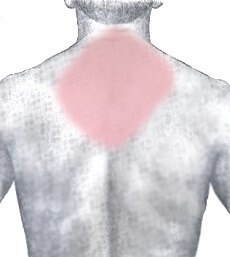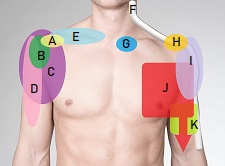- Home
- Diagnosis Guide
- Shoulder Blade Pain
Shoulder Blade Pain
Written By: Chloe Wilson BSc (Hons) Physiotherapy
Reviewed By: SPE Medical Review Board
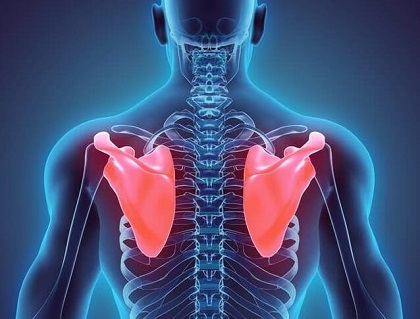
Shoulder blade pain is a common problem and can really affect daily life.
There may be an issue in the shoulder blade itself or the surrounding soft tissues, or the pain may be referred from somewhere else such as the neck or lungs.
Scapula pain may be caused by a minor problem such as a muscle strain or simply having slept awkwardly or something serious such as cancer or a heart problem. But how do you tell the difference?
We are going to look at the most common causes of pain in the shoulder blade area so you can work out whether there's a problem with the bones, soft tissues, nerves, an underlying medical problem or it's just down to poor posture. We'll also look at the structure of the shoulder blades and how to treat the problems that can arise.
What Causes Shoulder Blade Pain?
The most common causes of shoulder blade pain are:
- Bursitis: Constant, dull aching shoulder blade pain with snapping/grating/grinding noise/sensation with arm movements
- Muscle Problems: Dull ache that gets worse with arm movement and better with rest. Tends to only affect one arm/shoulder
- Posture: Aching pain between shoulder blades, worse after being in one position for a long time
- Nerve Problems: Associated with tingling/pins and needles, numbness and weakness. Symptoms often refer to other areas and may affect one or both shoulders/arms
- Bone Problems: Sudden, severe, sharp localised pain caused by an injury/accident
- Medical Disorders: Associated symptoms such as feeling unwell, chest pain, dizziness, nausea, weight loss and shortness of breath
Let’s look at each cause of scapula pain in more depth and how to treat them.
1. Scapulothoracic Bursitis
The most common cause of shoulder blade pain associated with a snapping, grinding or grating noise when moving the arm is scapulothoracic bursitis, aka snapping scapula syndrome.
Around the shoulder blade there are a number of bursa, small, fluid-filled sacs that sit between soft tissues and bone to allow smooth, friction-free movement.
Sitting on the front of the scapula is a large muscle called subscapularis. There are two bursa, one near the top of the scapula and one at the bottom that allow the scapula to glide smoothly over the ribcage.
Inflammation of the bursa, due to factors such as muscle weakness or tightness, poor posture or bony abnormalities can result in a persistent, dull, aching shoulder blade pain and a snapping/grating noise with arm movements. There may also be a lump on the shoulder blade.
Find out all about the common causes, symptoms, diagnosis and treatment options in the Snapping Scapula section.
2. Poor Posture
Poor posture is a really common cause of shoulder blade pain. There's that tell-tale pain between the shoulder blades and in the lower neck often accompanied by stiffness and discomfort.
In a world where we tend to spend lots of time hunched over at a desk, computer, sink or in the garden, poor posture and trapezius pain is a common problem.
The shoulders round forwards, the chin protrudes, chest and upper back muscles get weak. Areas of the spine stiffen, particularly the lower neck and upper back which can lead to aching shoulder blade pain, particularly across the upper back in between the shoulder blades.
There are some really simple things you can do to improve your posture and as well as adjusting your sitting position, it can also really help to do strengthening exercises for the shoulder, back and arm muscles and upper back stretches. Not only can they help to improve posture they also help to reduce any associated shoulder blade pain.
3. Trigger Points
Another common cause of shoulder blade pain is trigger points. Trigger points are small, tight bands in the muscle fascia which can be extremely sensitive to any touch. They often present as a small pea-sized lump in the muscle, most commonly in the trapezius muscle.
Trigger points are commonly found around the neck, upper back and shoulder blade area, causing shoulder blade pain usually described as a dull, deep, aching pain which may extend down one arm.
The best way to reduce the tightness and resultant shoulder blade pain from trigger points is with strengthening and stretching exercises.
4. Muscle Strain
Shoulder blade pain can also be caused by straining the muscles around the neck, shoulder and upper back. This usually develops due to overworking or over-stretching the muscles, most commonly from a new exercise regime, repetitive overhead arm activities like throwing, lifting or carrying something heavy like a backpack, or even sleeping awkwardly.
With a muscle strain there tends to be a dull ache around one or both shoulder blades that gets worse with activity and eases with rest, and the area may be tender to touch. Symptoms from muscle strain don’t usually refer into the arm.
Strengthening the rotator cuff and scapular stabilizer muscles are the best way to reduce muscular shoulder blade pain.
5. Rotator Cuff Tear
Rotator cuff tears can also cause pain in the shoulder blade too, depending on where the tear is.
The rotator cuff is a group of muscles that run between the scapula and the humerus and work together to move the shoulder joint.
If one of the muscles is torn, usually from prolonged repetitive arm work or an injury, there will most likely be pain around the shoulder which may refer down the arm and to the shoulder blade region, but usually only on one side. Tears may develop suddenly with an injury, or gradually with degeneration.
Rotator cuff tears usually cause a deep, dull, aching pain across the shoulders and shoulder blade and crepitus (popping/cracking noises) that get worse with arm movements. Arm weakness may also develop.
Find out all about how to reduce shoulder blade pain from rotator cuff tears and which exercises work best in the Rotator Cuff Tears section.
6. Neural Problems
It is fairly common for shoulder blade pain to originate from irritation of the nerves that come from the neck or upper back. These nerves commonly refer pain to the shoulder blade area and may be accompanied by tingling, pins and needles, numbness and/or weakness.
Your spinal cord runs down the centre of the spine, with nerves branching out at each spinal level which extend out like flexible wires. Signals run up and down the nerves to and from the spinal cord and brain controlling movement and sensation (touch).
There are a number of different things that can cause nerve damage which results in shoulder blade pain:
a) Disc Disease
Between each bone in your spine (vertebra) sits a squashy disc – think of it like a jam donut. This creates space and cushioning between the bones and ensures there is minimal pressure on the nerves where they come out of the spine. Discs can either lose height, or get squashed which can lead to neck, shoulder and scapula pain.
You can find out lots more about the causes, symptoms and treatment in the nerve pain section.
b) Brachial Neuritis
One of the less common causes of shoulder blade pain is Brachial Neuritis.
It is a rare condition where there is inflammation of the brachial plexus, an area where the nerves from the bottom of the neck pass across the front of the chest.
Symptoms of brachial neuritis usually develop suddenly, most commonly at night causing stabbing/sharp shoulder pain that may spread to neck, arm and shoulder blade pain.
You can find out all about how brachial neuritis causes shoulder blade pain including the causes, symptoms and treatment options in the Brachial Neuritis section.
c) Spinal Stenosis
Shoulder blade pain from spinal stenosis develops when there is abnormal narrowing of the spinal canal. Symptoms of spinal stenosis tend to be at their worst when standing and include shoulder, arm, hand and shoulder blade pain, numbness, weakness, balance problems and in severe cases can affect bladder and bowel function. In most cases, symptoms are bilateral (on both sides).
7. Upper Thoracic Syndrome
Upper Thoracic Syndrome, aka T4 syndrome, is a rare condition that results in a complex pattern of painful symptoms including shoulder blade pain. It typically affects people between ages of 20-40.
The thoracic spine forms the middle and upper back area, starting just below the neck. There are 12 thoracic bones (vertebra). T4 syndrome typically refers to damage or irritation around the fourth thoracic vertebra, although the problem may come from anywhere between T2-T7.
Symptoms of upper thoracic syndrome usually affect one arm, but can sometimes affect both, and tend to include diffuse (meaning it’s hard to pinpoint where the pain is coming from) arm, neck and shoulder blade pain, tingling/pins and needles/numbness, stiffness, muscle spasms and headaches. Pain often gets worse when pressure is applied directly to the T4 vertebra.
T4 syndrome symptoms tend to worse at night and are exacerbated by any movements of the upper and middle back such as twisting, bending, laughing, coughing and activities such as driving where the arms are reaching forwards and lifting. T4 syndrome is thought to be caused by factors such as stiffness, hypermobility, poor posture, repetitive bending/heavy lifting.
8. Shoulder Fractures
The shoulder blades are one of the most difficult bones in the body to break, so fractures here are very rare. It is basically impossible to break your shoulder blade without knowing about it, and it most commonly occurs due to a fall, collision or a motor vehicle accident. There is usually sudden, severe, sharp pain accompanied by an audible snap/pop/click sound and there is often a visible deformity. Shoulder blade pain usually worsens with any pressure over the scapula such as lying on your back
Scapular fractures usually cause severe shoulder blade pain and are often accompanied by other injuries which may be serious such as rib fractures and lung injuries.
Find Out More: Shoulder Fractures: Causes, Types & Treatment
9. Medical Issues
Organ disorders can often cause referred shoulder blade pain. They will usually have other accompanying symptoms as well, so if your only complaint is pain in the shoulder blade area, it is unlikely to be caused by any of these.
Common medical conditions that cause shoulder blade pain include:
a) Heart Problems
People typically think of heart problems being associated with chest pain and left arm pain, but shoulder blade pain is often a reported symptoms with heart problems, particularly in women.
The most common heart problem that causes pain in the shoulder blade area is a heart attack, where there is decreased blood flow to the heart either due to a clot or bleeding.
Other heart problems that can cause shoulder blade pain include pericarditis - inflammation of the lining of the heart, and aortic dissection - a tear in the aorta, the main artery that carries blood away from the heart.
If your chest and/or shoulder blade pain are severe, come on suddenly, are accompanied by dizziness, shortness of breath, rapid pulse, sweating, chest tightness or nausea, call 911 immediately. Heart problems are often a medical emergency – seek treatment immediately.
b) Lung Problems
Lung problems can also lead to referred shoulder blade pain. Lung problems that are often associated with pain in the shoulder blade area include:
- Pancoast Tumours: a type of lung tumor that grows on the top part of the lungs. Usually affects smokers and is associated with feeling generally unwell, weight loss and eye problems
- Pleurisy: inflammation of the lung lining – typically causes sharp chest pain when breathing deeply which may refer to the shoulder/shoulder blades
- Pneumothorax: a collection of air between the lung and the chest wall (pleural cavity) which causes part of the lung to collapse. Usually presents with sudden pain and shortness of breath and there may be a sharp pain between shoulder blades
c) Cancer
Some types of cancer spread to the bone known as metastases. Cancers that typically spread to the scapula causing shoulder blade pain include breast cancer, lung cancer, colon cancer and oesophageal cancer.
Shoulder blade pain from metastases is usually worse at night and will be accompanied by fatigue, weight loss, nausea and lack of appetite.
d) Abdominal Conditions
Problems in the abdominal organs can result in referred shoulder blade pain. Left shoulder blade pain may be caused by pancreatitis or irritable bowel syndrome (IBS) and right shoulder blade pain may be due to gallstones, peptic ulcers and liver disease such as liver cancer.
Shoulder Blade Pain Treatment
The best treatment for shoulder blade pain will depend on the underlying problem, but will usually include:
- Medications: to relieve pain and inflammation
- Ice/Heat: to reduce can and inflammation. Ice tends to work best in the early stages following an injury whereas heat works better with longer term pain
- Strengthening Exercises: For the rotator cuff muscles and scapular stabilization exercises
- Stretches: Upper back stretches and shoulder and upper arm stretches
- Posture Re-education: which may include changing your desk set up, chair etc - find out more
- Physical Therapy: rehab program, taping, posture advice
For more specific information on the different causes of shoulder blade pain check out the following articles:
- Scapulothoracic Bursitis Treatment
- How To Improve Posture
- Trigger Point Treatment
- Scapular Stabilization Exercises
- Rotator Cuff Tear Exercises
- Arm Nerve Pain Treatment
If you are suffering from shoulder blade pain, get checked out by your doctor, particularly if you are feeling unwell.
Shoulder Blade Anatomy
The shoulder blades are an integral part of the shoulder joint, also known as the scapula.
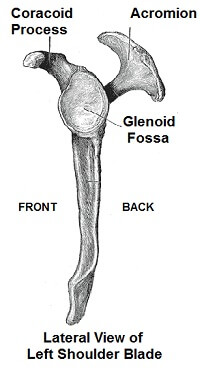
The main bulk of the bone is triangular in shape and sits over the back of the ribcage forming the scapulothoracic joint, but there are three protrusions at the top:
- Glenoid Fossa: a shallow cavity that fits with the top of the upper arm bone (humerus) forming the shoulder joint (a ball and socket joint)
- Acromion: An oblong projection over the top of the shoulder that forms a bridge over the rotator cuff muscles and forms a joint with the collar bone (clavicle) called the acromioclavicular joint
- Coracoid Process: a smooth hook shaped protrusion at the front of the shoulder
Eighteen different muscles attach to different parts of the shoulder blade, and each scapula can move:
- Up and Down - elevation and depression
- Forwards and Backwards - protraction and retraction
- Twist - upward and downward rotation
Shoulder Blade Pain Summary
Shoulder blade pain is a common problem that can affect people at any age.
There may be pain in the shoulder blades themselves, pain between the shoulder blades or upper back pain.
If your shoulder blade pain is accompanied by tingling or numbness, there is likely some nerve damage.
A clicking or grinding noise around your shoulder blades when you move your arm is often a sign of scapulothoracic bursitis or trapezius problems.
Muscle weakness and tightness and a lack of control around the shoulder blade are common causes of shoulder blade pain and respond well to stretching, strengthening and stability exercises.
If your pain extends into the shoulder or down the arm, visit the shoulder pain diagnosis section for help working out what is wrong.
You may also be interested in the following articles:
- Front Shoulder Pain
- Pain Behind The Shoulder
- Burning Shoulder Pain
- Shoulder Pain At Night
- Shoulder Clicking & Grinding
- Common Causes Of Shoulder Pain
Page Last Updated: 05/03/2023
Next Review Due: 05/03/2025

